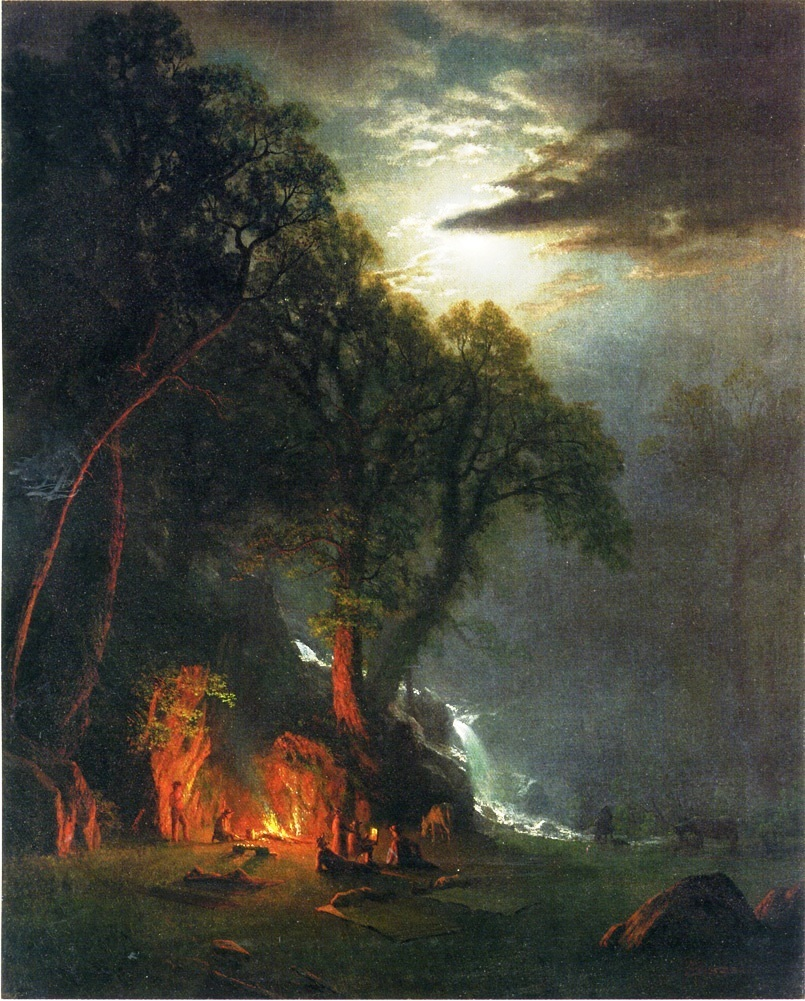Campfire Site, Yosemite

Christie's Lot Essay
Famed for his majestic views of the West, Albert Bierstadt first traveled there in 1859, in 1863 and again from 1871 to 1873. These trips produced nearly all of his most famous compositions. In the majority of these, the grandeur of the landscape and the subtle effects of light, especially luminous light, are a central concern. At times, he also explored more mysterious illumination in his depictions of moonlight and firelight to create a dramatic nocturnal scene, as evident in the present painting.
Here Bierstadt paints an expansive view, the focus of which is his party's encampment, likely in the Hetch Hetchy Valley of California. Trees tower above the campsite, which is lit by the orange and yellow glow of a blazing fire, radiating light off the surrounding rocks and the tree limbs far above. The brilliant light of the moon, partially obscured by clouds, transforms the stream into a silvery ribbon. Men gather around the fire and nearby, others gather around the artist, seated at an easel, painting the moonlit landscape before him. Next to Bierstadt stands a woman in a jacket and skirt, almost certainly his wife, Rosalie Osborne Ludlow, who accompanied the artist on his month-long 1873 trip to the Yosemite Valley, thereby providing a likely date for the creation of this painting.
Campfire Site, Yosemite, relates to an earlier, smaller composition, The Trapper's Camp of 1861 (Yale University Art Gallery, New Haven, Connecticut), which depicts two men and a broadly similar conception of moonlight and firelight in the Rocky Mountain wilderness. Bierstadt expands the theme in The Burning Ship (1871, Shelburne Museum, Shelburne, Vermont), in which flames engulf a whaler ship off the Island of Ascension, lit by the moon, on an otherwise calm evening. The same year, Bierstadt painted perhaps his most monumental campfire and moonlight landscape with his Mountainous Landscape by Moonlight (The Corcoran Gallery of Art, Washington, D.C.), in which a small group of men cluster near a fire and in the distance, a mountain peak looms above the scene.
In its details, Campfire Site, Yosemite differs from these works in its more personal subject, recording the artist and his wife in rough country. It also provides a vivid image of the now vanished Hetch Hetchy Valley, which was submerged in 1923 with the construction of the O'Shaughnessy Dam. In this work, Bierstadt strives to capture a personal and particular image of Yosemite, possibly his most famous Western subject. In the painting, he bridges the majestic and the personal--creating a unique work that draws upon the iconic images of his celebrated Western landscapes, transformed into a remembrance likely painted for his own pleasure and the enjoyment of his family and friends. Summarizing Bierstadt's public achievement, the art historian, Nancy Anderson writes, "In paintings that became visual sanctuaries, (much the way national parks became literal sanctuaries), Bierstadt offered safe haven for the wilderness myth that lay at the heart of America's definition of itself." (Albert Bierstadt, Art & Enterprise, New York, 1990, p. 105) Here, that haven is also a personal one for the artist.
Backlinks